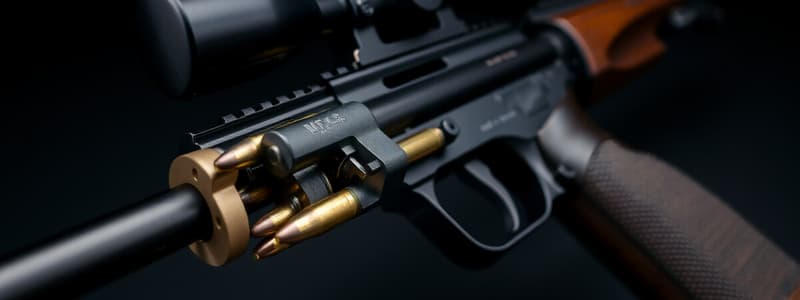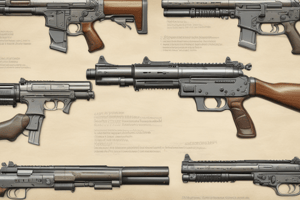Podcast
Questions and Answers
What was the earliest type of handgun described in the content?
What was the earliest type of handgun described in the content?
- A flintlock pistol
- A small cannon (correct)
- A revolver
- A repeating rifle
What was the primary method of igniting the priming charge in early firearms?
What was the primary method of igniting the priming charge in early firearms?
- With a hot iron or lighted match (correct)
- With a percussion cap
- With a fuse
- With an electric spark
In what year were 'hand cannons' confirmed to be used in Ghent, according to the content?
In what year were 'hand cannons' confirmed to be used in Ghent, according to the content?
- 1311
- 1313 (correct)
- 1247
- 1449
What factor adversely affected the firing mechanism of early firearms?
What factor adversely affected the firing mechanism of early firearms?
What role does a touch hole play in early firearms?
What role does a touch hole play in early firearms?
What was the main advantage of the wheel lock over the matchlock?
What was the main advantage of the wheel lock over the matchlock?
Which component of the wheel lock was crucial for keeping the wheel from unwinding until it was triggered?
Which component of the wheel lock was crucial for keeping the wheel from unwinding until it was triggered?
What mechanism did the wheel lock use to ignite the priming charge?
What mechanism did the wheel lock use to ignite the priming charge?
What feature of the arquebus allowed it to be fired from the shoulder?
What feature of the arquebus allowed it to be fired from the shoulder?
What was the primary role of the iron pyrite in the design of the wheel lock?
What was the primary role of the iron pyrite in the design of the wheel lock?
Flashcards are hidden until you start studying
Study Notes
Objectives of the Chapter
- Understand different types of firearms.
- Learn the mechanisms of firearms.
- Explore the role of firearms in the field of ballistics.
Brief History of Firearms
- Earliest handguns resembled small cannons made of wrought iron or bronze, loaded from the muzzle with gunpowder and ball.
- The ignition system involved a touch hole for a priming charge, ignited by a hot iron or match.
- Early models were slow and unreliable, especially in wet conditions, with documented use in Spain from 1247 and in Belgium around 1313.
- Notable illustration of hand cannons appeared in a 15th-century fresco in Italy.
- The hand cannon's cavalry use was first recorded in 1449, featuring refinements for better firing mechanisms.
Development of Firearm Mechanisms
- The wheel lock eliminated the need for a lit match, transforming ambush tactics and hunting.
- The arquebus, fired from the shoulder, featured a curved butt and a hook for stability during firing.
- A serrated steel wheel design allowed for ignition with iron pyrite, enhancing reliability and aim.
- This wheel lock mechanism was likely developed by Mann Le Bourgeoys in 1615.
Advancement to Percussion System
- The flintlock remained popular until 1807 when Alexander John Forsyth introduced mercury fulminate for ignition, simplifying the firing process.
- The percussion system paved the way for self-contained cartridges, revolutionizing firearm design.
Introduction of Pinfire System
- Pinfire weapons, first showcased in 1851, were breech-loading and featured self-contained cartridges combining propellant, missile, and primer.
- Popular in Europe from 1890 to 1910, the pinfire system saw decreased favor after 1914 in England.
Centre Fire System
- A significant advancement in weaponry, centre fire ammunition allowed for higher pressure due to stronger material cartridges.
- Simplified primer design meant only the primer cup needed to be crushable.
Importance of Rifling
- Rifling consists of spiral grooves in the barrel to stabilize bullets, enhancing accuracy.
- Potential origins trace back to gunmakers in the 15th century, with identifiable rifled guns existing by the late 1400s.
Twist Rate in Rifling
- George Greenhill developed a formula to calculate the appropriate twist rate for firearms based on bullet length and diameter.
- Example calculations show rotational speeds for different calibers and twist rates, emphasizing the importance of twist in projectile stability.
Revolvers and Their History
- Revolvers feature a revolving cylinder with several firing chambers, historically influenced by Samuel Colt.
- Early designs predate Colt, including snaphaunce revolvers from the reign of Charles I and earlier models from Henry VIII's time.
Self-Loading Pistols
- The concept of self-loading pistols emerged early but required advancements in cartridge design and metallurgy to become feasible.
- Historical claims of fast-firing pistols date back to 1664, highlighting early interest in rapid-fire mechanisms.
Studying That Suits You
Use AI to generate personalized quizzes and flashcards to suit your learning preferences.



